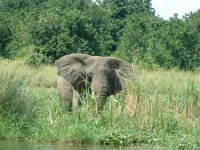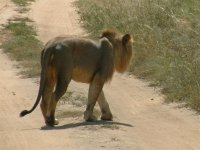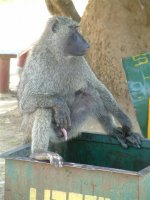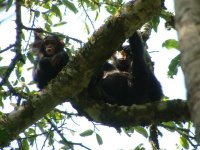birdboybowley
Well-known member.....apparently so ;)

Hey all, just getting around to writing up this trip report so bear me.....
Along with my two good friends, Ewan Urquhart and Chris Glanfield, we decided upon an intense birding trip to nail some of the specialties Uganda has to offer and to also partake in its gorilla-trekking opportunities. Roughly the same size as the UK, Uganda has a vast species list and a great diversity of habitats ensuring that any trip here will always yield dividends. After trawling through numerous trip reports, Ewan reckoned on utilizing Bird Uganda Safaris (www.birduganda.com) and after some very good negotiating and perseverance on his part with the owner, Herbert Byaruhanga, we had a 16-day itinerary booked for a cost of £1900 each which covered all logistics, food and the US$500 gorilla fee (higher than we would’ve liked but remember the £-$ rate wasn’t particularly great this summer and all prices in Uganda are based on the US$). The basic itinerary would take in the country’s best sites including Murchison, Semliki, Bwindi, Lake Mburo, Budongo and Kibale and give us a good selection of birds and animals. We ended up with a group total of 492 birds and 40 mammals with a couple of bats and rodents remaining unidentified.
The flights were booked through British Airways for £598 each - steep I know, but BA are still the only carrier that flies direct to Entebbe and the other fares available were only £50 or so cheaper so just weren’t worth the extra hassle of a transfer. The flight times were 7h45 outbound and 8h15 inbound and the B767 we were on thankfully had a personal IFE system with a wide choice of films and music available to pass the time more quickly and the crew was friendly and chatty on both sectors (is it just me or are flight crews now younger than the cabin crew??!!). Also, Uganda is only GMT+2hr so no jet-lag to worry about either!
Daybreak was around 0600 and sunset was about 1830. The weather was generally fine and sunny with the hottest temperatures being in the north around Murchison. A few heavy showers were encountered in the western ranges where the night-time temperature dropped to a comfortably cool level too. Anti-malarials were taken as standard and pleasingly, bugs weren’t much of a problem either, except in the ‘tsetse zone’ – a c10km area through South Murchison where the things are seriously voracious! Had a couple of mozzies in various rooms but nothing a shoe didn’t sort out....! Ants could be a painful distraction if you happened to step on a swarm – most people looked at me a bit funny when I went into the forests in ¾ length shorts but I found that the ants were a lot easier to see and get rid of, whereas long trousers or jeans gave them far too much cover to get up to some more sensitive areas for my liking (just ask Chris...!!)
We used the Birds of East Africa by Stevenson & Fanshawe as our primary reference and Herbert also had a copy and many other guides for mammals, reptiles and butterflies in the van, a Toyota Hiace that could seat 7, so the 3 of us were very comfortable. A large safari-roof opened up and allowed the 3 of us ample space to stand for better views. Mobile reception was generally pretty good, there are a number of cash-points (including a Barclay’s at the airport) and changing money in banks was simple enough (although time-consuming!). The exchange rate was roughly US$1=2000 Uganda Shillings, with beers and soft drinks costing from 1500-2500 depending on location – so pretty damn good!!
Day-by-day Itinerary:
10th June – We landed at 0725 and soon had out first lifers in the shape of African Pied Wag and nesting Angola Swallows as we queued for immigration. We soon met up with Paul, our guide for the first few days, as we cleared customs and accompanying him was Cissie who will soon be in charge of the office and designing tours to cater for clients’ needs – for this reason she apparently had to know where she was talking about so here she was! As we walked to the van in the carpark, a couple of smart Grey-backed Fiscals and Ruppell’s Glossy-Starlings were seen, along with Speckled Pigeons and Dark-capped Bulbuls whilst White-rumped and African Palm-Swifts wheeled overhead. A quick roadside stop literally just outside the airport gave us a large flock of Fan-tailed Widowbirds and Village Weavers, several Pin-tailed Whydahs, Mosque Swallow, Pied Crow, Hadada Ibises, Pied Kingfisher, Red-eyed Dove, a single Grey Woodpecker and a few Broad-billed Rollers. Paul asked if we’d like to dump our gear or go straight to the Botanical Gardens to bird.....silly question and c20mins later we were parking up by the gates.
View attachment hornbill black&whitecasqued (6).BMP
The gardens themselves are situated on the shore of Lake Victoria and offer a great introduction to the commoner species to be expected, have some excellent habitat and are a great place to lose yourself in for a few hours. As we gathered our bits and pieces, new birds began to show in the form of a stunning Double-toothed Barbet, a pair of Black-&-White-Casqued Hornbills, several soaring African Openbills and old acquaintances such as Palmnut Vulture, African Green-Pigeon, Hamerkop, Gymnogene, African Thrush, Blue-spotted Wood-Dove, Grey-backed Camaroptera, Bronze Munia, Red-billed Firefinch and Klaas’ Cuckoo made a welcome return as we set off along the path to spend a great 4hrs birding. We soon had a wealth of weavers – Slender-billed, Vieillot’s Black, Holub’s Golden, Golden-backed, Grosbeak, Black-necked and Black-headed all present in the surrounding vegetation – and sunbirds such as Red-chested, Scarlet-chested, Collared, Olive-bellied, Superb, Western Olive and Green-headed were also added, whilst other goodies included our first awesome Great Blue Turaco, a female Vanga Fly, Superb Glossy-Starling, Eastern Grey Plantain-eaters and African Black-headed Oriole. The ground was covered in thousands of small dragonflies that took off en masse as we walked through them.
Overhead, a pair of vocal African Fish-Eagles was ever-present and huge Marabous drifted over also. A brisk wind whipped in across the vast Lake Victoria, upon which we saw Pink-backed Pelicans, Egyptian Goose, Yellow-billed Duck, Black-headed Heron, Long-toed Lapwing, Cattle and Little Egrets and Long-tailed and White-breasted Cormorants. I don’t think I’ve ever seen so many Pied Kingfishers together either – there must’ve been at least 80! Further round, near the ‘restaurant’ we found a very active area of forest with several Diederik Cuckoos, 4 gorgeous Ross’ Turacos, 2 Crowned Hornbills, Heuglin’s and Snowy-crowned Robin-Chats, Red-bellied Paradise-Fly, Green Crombec, Dusky-blue Fly, Little Greenbul, Yellow-throated Leaflove, Tambourine Dove, Black & White Munias and a female Black Cuckooshrike. A couple of African Pygmy-Kingfishers were seen perched deep in smaller bushes and the numerous noisy Woodland Kingfishers were impossible to miss – two very vocal birds that we did miss seeing were Grey-capped Warbler and White-spotted Flufftail. On the mammalian front we had a group of gorgeous Guereza Colobus, Vervet Monkeys and several Red-legged Sun-Squirrels.
By 1300, we were back at the van and moving on to our first accommodation, the nearby Sophie’s Motel where several Northern Brown-throated Weavers and Speckled Mousebirds welcomed us upon our arrival.
View attachment mousebird speckled (5).BMP
The motel was ok, rooms had private facilities and 24hr electricity and there is internet access down by reception also. Food and drinks are available in the upstairs restaurant, the food being alright but nothing special, although the tilapi was very nice (and I don’t usually eat fish!). After dumping our gear, we had our first ding-dong with Paul as he was about to leave us be and see us in the morning....er, don’t think so! So we had an hour’s break and then went back to the gardens again by 1530 and went in by another entrance.
As we parked up a stunning Black-headed Gonolek was seen in the tree above us and as we walked along we soon had Northern Black-Fly, Wahlberg’s Eagle, African Pied Hornbill, Tawny-flanked and White-chinned Prinias, Red-faced Cisticola, and several Yellow-throated Tinkerbirds. Along the lakeside we had excellent close views of Hadada Ibis and a perched African Openbill and 5 Blue-breasted Bee-eaters fed from the bushes. Chris and I then struck lucky with a fine Orange Weaver as it flew from the lower bushes into a tall tree but the mood changed rapidly as we wandered back through the centre of the gardens where we came across a truly distressing sight – earlier we had watched quite a few of the numerous Yellow-billed Kites dipping down to snatch things from the lake’s surface and now we were looking up at two, 1 now very dead, caught and snagged and hanging upside down by what looked like fishing line in the topmost branches of probably the biggest trees around. Quite powerless to do anything about it, this was the first time I think I’d’ve liked a gun to hand....On a more positive note, we had 5 Meyer’s Parrots and a pair of African Grey Parrots inspecting a nest-hole – it was excellent to experience these all-too-familiar cagebirds as they should be seen, wild and free, and a fitting end to our first day.
11th June – God, what a night! The noise from the motel’s car park below our window was like sleeping in a truck stop....0300 and I’m sure there was someone revving a tank up down there and obviously having to shout to his hard-of-hearing friends...not impressed!! The Hadada Ibises that roost in the trees surrounding the carpark also make one hell of a racket as they leave!! We had breakfast and were on the road by 0710.
View attachment fly vanga (3).BMP
After a couple of roadside stops en route with excellent views of a cracking male Vanga Fly perched atop a bare tree and display-flying and also mobbing a Crowned Hornbill that dared land in the next tree, a superb white-morph African Paradise-Fly, African Grey Parrot, White-headed Saw-wings, Little Bee-eater, Sooty Chat, African Dusky and African Blue-Flys and smart Lesser Striped Swallows seen, we reached Mabamba Swamp by 0900, and were soon ensconced in two canoes and paddling down the channels through the papyrus stands for the next couple of hours. Some good birds were seen including 4 African Marsh Harrier, Black Crake, African Jacana, Malachite Kingfisher, Common Waxbill, 2 Blue-headed Coucal and some nice flocks of smart-looking Weyn’s Weavers.
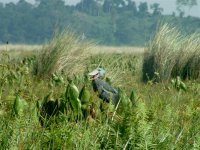
Soon we were floating out amongst the huge water-lilies and trying to balance whilst standing up in the boat when our main quarry was sighted in the distance as a large grey lump moved and yawned, its huge bill glistening in the morning sun – a magnificent Shoebill! We manoeuvred the boats closer and soon the cameras were clicking away as we watched this prehistoric-looking bird, all of us agreeing that it wouldn’t look out of place in Jurassic Park and anyone who doubts dinosaurs eventually became birds should just come here and look at these things! Another suddenly flew in looking for all the world like an avian B-52 and landed even closer to us and yet another was seen flying further out which brought our total to three, which considering that there are only 9 birds at the site, was pretty damn good! Absolutely fabulous birds and one I’d wanted to see for years!
A shout from behind had us whipping round in time to get a great bonus in the form of a Rufous-bellied Heron as it flew by and landed in a distant bush – excellent! As we left we turned down one last tributary and soon were watching a delicate Lesser Jacana run across the lilies into cover. We docked and left along the dusty roads and stopped at an area of the reserve that borders the road where Paul got out his i-pod (with its temperamental speakers which didn’t impress) and soon we had great views of the local Papyrus Gonolek but the White-winged Swamp-Warbler unfortunately didn’t want to play. We meandered our way back through the capital Kampala and finally got onto the main road north to Masindi. The road itself is in pretty good condition, the going only hampered by the fascination with multiple vicious speed-bumps around the numerous villages and of course the number one rule of African driving: the biggest vehicle has right of way no matter which side of the road it’s on!!
View attachment stork saddlebilledfem (2).BMP
We stopped at a good swampy/grassy habitat near the border of the Nakasongola/Luwero Districts where we had a superb female Saddle-billed Stork, Marsh Tchagra, Compact and Little Weavers, Black-headed Batis, Common Wattle-eye, Yellow-fronted and Brimstone Canaries, Striped Kingfisher, African Firefinch, Swahili Sunbird (split from Marico), Scarce Swift, Yellow-shouldered Widowbird, Winding Cisticola, Bateleur, Dark Chanting-Gos, Lizard Buzzard, several Long-crested and a light-phase Booted Eagle and Little Swifts. Later (after an unscheduled pit-stop for Ewan’s emergency dump!) we stopped in some promising drier habitat where we had a brilliant pair of White-crested Turacos, African Moustached Warbler, Western Black-headed Orioles, White-shouldered Black-Tit, African Grey Hornbill, Fork-tailed Drongo, Greater and Lesser Blue-eared Glossy-Starlings, Senegal Coucal and Red-cheeked Cordon-bleus. Here we also heard Scaly Francolin, Red-necked Spurfowl, Black Cuckoo and Red-headed Lovebird. A bonus Swamp Nightjar flew across the road as dusk fell as we neared Masindi. We reached the New Court View Hotel by 1945 and had a lovely meal with refreshingly cold Clubs. The place is owned by an English woman and is pretty good – the bungalow we were in had private facilities and a fan although we came unstuck with the shower as the red tap was actually the cold one.....oops, oh well, nothing like a cold shower to liven you up!
To be continued.....
Along with my two good friends, Ewan Urquhart and Chris Glanfield, we decided upon an intense birding trip to nail some of the specialties Uganda has to offer and to also partake in its gorilla-trekking opportunities. Roughly the same size as the UK, Uganda has a vast species list and a great diversity of habitats ensuring that any trip here will always yield dividends. After trawling through numerous trip reports, Ewan reckoned on utilizing Bird Uganda Safaris (www.birduganda.com) and after some very good negotiating and perseverance on his part with the owner, Herbert Byaruhanga, we had a 16-day itinerary booked for a cost of £1900 each which covered all logistics, food and the US$500 gorilla fee (higher than we would’ve liked but remember the £-$ rate wasn’t particularly great this summer and all prices in Uganda are based on the US$). The basic itinerary would take in the country’s best sites including Murchison, Semliki, Bwindi, Lake Mburo, Budongo and Kibale and give us a good selection of birds and animals. We ended up with a group total of 492 birds and 40 mammals with a couple of bats and rodents remaining unidentified.
The flights were booked through British Airways for £598 each - steep I know, but BA are still the only carrier that flies direct to Entebbe and the other fares available were only £50 or so cheaper so just weren’t worth the extra hassle of a transfer. The flight times were 7h45 outbound and 8h15 inbound and the B767 we were on thankfully had a personal IFE system with a wide choice of films and music available to pass the time more quickly and the crew was friendly and chatty on both sectors (is it just me or are flight crews now younger than the cabin crew??!!). Also, Uganda is only GMT+2hr so no jet-lag to worry about either!
Daybreak was around 0600 and sunset was about 1830. The weather was generally fine and sunny with the hottest temperatures being in the north around Murchison. A few heavy showers were encountered in the western ranges where the night-time temperature dropped to a comfortably cool level too. Anti-malarials were taken as standard and pleasingly, bugs weren’t much of a problem either, except in the ‘tsetse zone’ – a c10km area through South Murchison where the things are seriously voracious! Had a couple of mozzies in various rooms but nothing a shoe didn’t sort out....! Ants could be a painful distraction if you happened to step on a swarm – most people looked at me a bit funny when I went into the forests in ¾ length shorts but I found that the ants were a lot easier to see and get rid of, whereas long trousers or jeans gave them far too much cover to get up to some more sensitive areas for my liking (just ask Chris...!!)
We used the Birds of East Africa by Stevenson & Fanshawe as our primary reference and Herbert also had a copy and many other guides for mammals, reptiles and butterflies in the van, a Toyota Hiace that could seat 7, so the 3 of us were very comfortable. A large safari-roof opened up and allowed the 3 of us ample space to stand for better views. Mobile reception was generally pretty good, there are a number of cash-points (including a Barclay’s at the airport) and changing money in banks was simple enough (although time-consuming!). The exchange rate was roughly US$1=2000 Uganda Shillings, with beers and soft drinks costing from 1500-2500 depending on location – so pretty damn good!!
Day-by-day Itinerary:
10th June – We landed at 0725 and soon had out first lifers in the shape of African Pied Wag and nesting Angola Swallows as we queued for immigration. We soon met up with Paul, our guide for the first few days, as we cleared customs and accompanying him was Cissie who will soon be in charge of the office and designing tours to cater for clients’ needs – for this reason she apparently had to know where she was talking about so here she was! As we walked to the van in the carpark, a couple of smart Grey-backed Fiscals and Ruppell’s Glossy-Starlings were seen, along with Speckled Pigeons and Dark-capped Bulbuls whilst White-rumped and African Palm-Swifts wheeled overhead. A quick roadside stop literally just outside the airport gave us a large flock of Fan-tailed Widowbirds and Village Weavers, several Pin-tailed Whydahs, Mosque Swallow, Pied Crow, Hadada Ibises, Pied Kingfisher, Red-eyed Dove, a single Grey Woodpecker and a few Broad-billed Rollers. Paul asked if we’d like to dump our gear or go straight to the Botanical Gardens to bird.....silly question and c20mins later we were parking up by the gates.
View attachment hornbill black&whitecasqued (6).BMP
The gardens themselves are situated on the shore of Lake Victoria and offer a great introduction to the commoner species to be expected, have some excellent habitat and are a great place to lose yourself in for a few hours. As we gathered our bits and pieces, new birds began to show in the form of a stunning Double-toothed Barbet, a pair of Black-&-White-Casqued Hornbills, several soaring African Openbills and old acquaintances such as Palmnut Vulture, African Green-Pigeon, Hamerkop, Gymnogene, African Thrush, Blue-spotted Wood-Dove, Grey-backed Camaroptera, Bronze Munia, Red-billed Firefinch and Klaas’ Cuckoo made a welcome return as we set off along the path to spend a great 4hrs birding. We soon had a wealth of weavers – Slender-billed, Vieillot’s Black, Holub’s Golden, Golden-backed, Grosbeak, Black-necked and Black-headed all present in the surrounding vegetation – and sunbirds such as Red-chested, Scarlet-chested, Collared, Olive-bellied, Superb, Western Olive and Green-headed were also added, whilst other goodies included our first awesome Great Blue Turaco, a female Vanga Fly, Superb Glossy-Starling, Eastern Grey Plantain-eaters and African Black-headed Oriole. The ground was covered in thousands of small dragonflies that took off en masse as we walked through them.
Overhead, a pair of vocal African Fish-Eagles was ever-present and huge Marabous drifted over also. A brisk wind whipped in across the vast Lake Victoria, upon which we saw Pink-backed Pelicans, Egyptian Goose, Yellow-billed Duck, Black-headed Heron, Long-toed Lapwing, Cattle and Little Egrets and Long-tailed and White-breasted Cormorants. I don’t think I’ve ever seen so many Pied Kingfishers together either – there must’ve been at least 80! Further round, near the ‘restaurant’ we found a very active area of forest with several Diederik Cuckoos, 4 gorgeous Ross’ Turacos, 2 Crowned Hornbills, Heuglin’s and Snowy-crowned Robin-Chats, Red-bellied Paradise-Fly, Green Crombec, Dusky-blue Fly, Little Greenbul, Yellow-throated Leaflove, Tambourine Dove, Black & White Munias and a female Black Cuckooshrike. A couple of African Pygmy-Kingfishers were seen perched deep in smaller bushes and the numerous noisy Woodland Kingfishers were impossible to miss – two very vocal birds that we did miss seeing were Grey-capped Warbler and White-spotted Flufftail. On the mammalian front we had a group of gorgeous Guereza Colobus, Vervet Monkeys and several Red-legged Sun-Squirrels.
By 1300, we were back at the van and moving on to our first accommodation, the nearby Sophie’s Motel where several Northern Brown-throated Weavers and Speckled Mousebirds welcomed us upon our arrival.
View attachment mousebird speckled (5).BMP
The motel was ok, rooms had private facilities and 24hr electricity and there is internet access down by reception also. Food and drinks are available in the upstairs restaurant, the food being alright but nothing special, although the tilapi was very nice (and I don’t usually eat fish!). After dumping our gear, we had our first ding-dong with Paul as he was about to leave us be and see us in the morning....er, don’t think so! So we had an hour’s break and then went back to the gardens again by 1530 and went in by another entrance.
As we parked up a stunning Black-headed Gonolek was seen in the tree above us and as we walked along we soon had Northern Black-Fly, Wahlberg’s Eagle, African Pied Hornbill, Tawny-flanked and White-chinned Prinias, Red-faced Cisticola, and several Yellow-throated Tinkerbirds. Along the lakeside we had excellent close views of Hadada Ibis and a perched African Openbill and 5 Blue-breasted Bee-eaters fed from the bushes. Chris and I then struck lucky with a fine Orange Weaver as it flew from the lower bushes into a tall tree but the mood changed rapidly as we wandered back through the centre of the gardens where we came across a truly distressing sight – earlier we had watched quite a few of the numerous Yellow-billed Kites dipping down to snatch things from the lake’s surface and now we were looking up at two, 1 now very dead, caught and snagged and hanging upside down by what looked like fishing line in the topmost branches of probably the biggest trees around. Quite powerless to do anything about it, this was the first time I think I’d’ve liked a gun to hand....On a more positive note, we had 5 Meyer’s Parrots and a pair of African Grey Parrots inspecting a nest-hole – it was excellent to experience these all-too-familiar cagebirds as they should be seen, wild and free, and a fitting end to our first day.
11th June – God, what a night! The noise from the motel’s car park below our window was like sleeping in a truck stop....0300 and I’m sure there was someone revving a tank up down there and obviously having to shout to his hard-of-hearing friends...not impressed!! The Hadada Ibises that roost in the trees surrounding the carpark also make one hell of a racket as they leave!! We had breakfast and were on the road by 0710.
View attachment fly vanga (3).BMP
After a couple of roadside stops en route with excellent views of a cracking male Vanga Fly perched atop a bare tree and display-flying and also mobbing a Crowned Hornbill that dared land in the next tree, a superb white-morph African Paradise-Fly, African Grey Parrot, White-headed Saw-wings, Little Bee-eater, Sooty Chat, African Dusky and African Blue-Flys and smart Lesser Striped Swallows seen, we reached Mabamba Swamp by 0900, and were soon ensconced in two canoes and paddling down the channels through the papyrus stands for the next couple of hours. Some good birds were seen including 4 African Marsh Harrier, Black Crake, African Jacana, Malachite Kingfisher, Common Waxbill, 2 Blue-headed Coucal and some nice flocks of smart-looking Weyn’s Weavers.

Soon we were floating out amongst the huge water-lilies and trying to balance whilst standing up in the boat when our main quarry was sighted in the distance as a large grey lump moved and yawned, its huge bill glistening in the morning sun – a magnificent Shoebill! We manoeuvred the boats closer and soon the cameras were clicking away as we watched this prehistoric-looking bird, all of us agreeing that it wouldn’t look out of place in Jurassic Park and anyone who doubts dinosaurs eventually became birds should just come here and look at these things! Another suddenly flew in looking for all the world like an avian B-52 and landed even closer to us and yet another was seen flying further out which brought our total to three, which considering that there are only 9 birds at the site, was pretty damn good! Absolutely fabulous birds and one I’d wanted to see for years!
A shout from behind had us whipping round in time to get a great bonus in the form of a Rufous-bellied Heron as it flew by and landed in a distant bush – excellent! As we left we turned down one last tributary and soon were watching a delicate Lesser Jacana run across the lilies into cover. We docked and left along the dusty roads and stopped at an area of the reserve that borders the road where Paul got out his i-pod (with its temperamental speakers which didn’t impress) and soon we had great views of the local Papyrus Gonolek but the White-winged Swamp-Warbler unfortunately didn’t want to play. We meandered our way back through the capital Kampala and finally got onto the main road north to Masindi. The road itself is in pretty good condition, the going only hampered by the fascination with multiple vicious speed-bumps around the numerous villages and of course the number one rule of African driving: the biggest vehicle has right of way no matter which side of the road it’s on!!
View attachment stork saddlebilledfem (2).BMP
We stopped at a good swampy/grassy habitat near the border of the Nakasongola/Luwero Districts where we had a superb female Saddle-billed Stork, Marsh Tchagra, Compact and Little Weavers, Black-headed Batis, Common Wattle-eye, Yellow-fronted and Brimstone Canaries, Striped Kingfisher, African Firefinch, Swahili Sunbird (split from Marico), Scarce Swift, Yellow-shouldered Widowbird, Winding Cisticola, Bateleur, Dark Chanting-Gos, Lizard Buzzard, several Long-crested and a light-phase Booted Eagle and Little Swifts. Later (after an unscheduled pit-stop for Ewan’s emergency dump!) we stopped in some promising drier habitat where we had a brilliant pair of White-crested Turacos, African Moustached Warbler, Western Black-headed Orioles, White-shouldered Black-Tit, African Grey Hornbill, Fork-tailed Drongo, Greater and Lesser Blue-eared Glossy-Starlings, Senegal Coucal and Red-cheeked Cordon-bleus. Here we also heard Scaly Francolin, Red-necked Spurfowl, Black Cuckoo and Red-headed Lovebird. A bonus Swamp Nightjar flew across the road as dusk fell as we neared Masindi. We reached the New Court View Hotel by 1945 and had a lovely meal with refreshingly cold Clubs. The place is owned by an English woman and is pretty good – the bungalow we were in had private facilities and a fan although we came unstuck with the shower as the red tap was actually the cold one.....oops, oh well, nothing like a cold shower to liven you up!
To be continued.....




